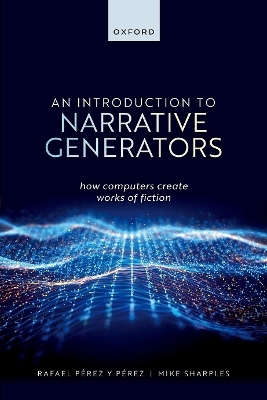
An Introduction to Narrative Generators
Oxford University Press (Verlag)
978-0-19-887660-1 (ISBN)
Combining an introduction to relevant concepts related to automatic storytelling with accessible descriptions of well-known computer programs that illustrate how such concepts are employed, the book is aimed at an interdisciplinary audience and assumes little or no background in computer science.
The book introduces the most relevant techniques employed over the last 60 years for the development of computer models for narrative generation, including narrative templates, problem-solving, planning, author engagement and reflection, and statistical methods such as deep neural networks, ending with an examination of the societal implications of the development of automatic narrative generator systems.
Rafael Pérez y Pérez is a Professor at the Universidad Autónoma Metropolitana at Cuajimalpa, México City. He gained a PhD in Artificial Intelligence from the University of Sussex. He specializes in computational creativity, particularly in models for narrative generation. From 2014 to 2019 he was the chair of the Association for Computational Creativity (computationalcreativity.net), which organises the annual International Conference on Computational Creativity (ICCC). His works include Story machines: how computers have become creative writers, MEXICA: 20 Years - 20 Stories, Creatividad Computacional, and several papers about AI and computational creativity. Mike Sharples is Emeritus Professor of Educational Technology at The Open University. He gained a PhD in Cognition, Computers and Creative Writing from the Department of Artificial Intelligence, University of Edinburgh. He is co-author of Story Machines: How Computers Have Become Creative Writers and author of How We Write: Writing as Creative Design. His other works include Computers and Thought: A Practical Introduction to Artificial Intelligence, plus over 300 books and papers on artificial intelligence, computers and writing, and educational technology.
1: The power to narrate
2: Narrative templates
3: Narrative generation from the character's perspective: problem solving
4: A methodology to design a narrative generator based on problem-solving
5: Generating a narrative step by step
6: Narrative generation from the author's perspective: planning
7: Representing the author's experience in planning
8: Weaving texts with patterns: the power of repetition
9: Inspired by the brain: a single neuron
10: Inspired by the brain: deep neural networks
11: MEXICA
12: Endless ways to use computers to study narrative generation (part 1)
13: Endless ways to use computers to study narrative generation (part 2)
14: The story we always wanted to tell you
| Erscheinungsdatum | 20.07.2023 |
|---|---|
| Verlagsort | Oxford |
| Sprache | englisch |
| Maße | 161 x 242 mm |
| Gewicht | 508 g |
| Themenwelt | Geisteswissenschaften ► Sprach- / Literaturwissenschaft ► Literaturwissenschaft |
| Informatik ► Theorie / Studium ► Künstliche Intelligenz / Robotik | |
| Naturwissenschaften | |
| ISBN-10 | 0-19-887660-2 / 0198876602 |
| ISBN-13 | 978-0-19-887660-1 / 9780198876601 |
| Zustand | Neuware |
| Haben Sie eine Frage zum Produkt? |
aus dem Bereich


